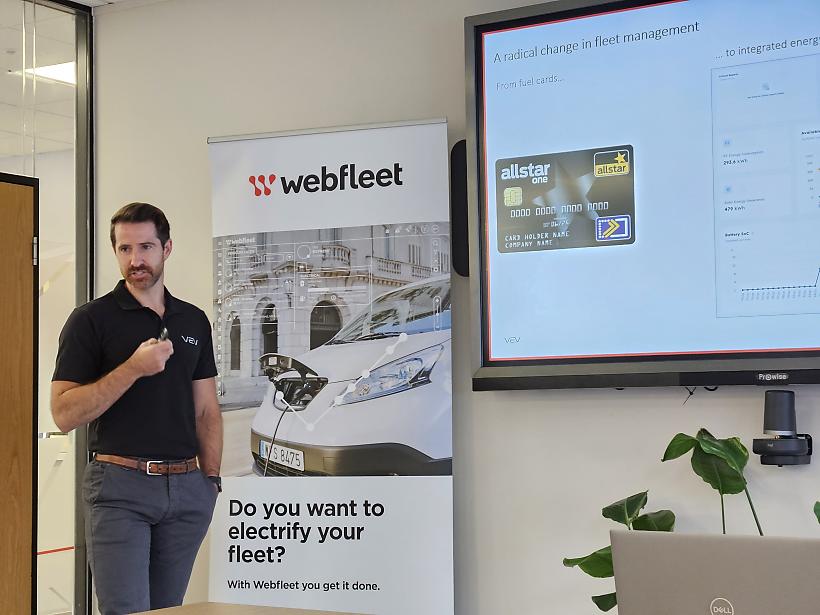The path to electrification requires ongoing consideration, with an increasing number of factors to take into account. But where do you begin? Are you a fleet operator and do you feel daunted by the prospect?
To address these questions and ease concerns for our customers, we hosted our first EV Lounge event.
This blog will revisit some of the most memorable advice given during the online event on September 20, with eight tips listed below.
Watch on-demand content from the exclusive Webfleet Customer EV event here. Each presentation delves into the growing ECV industry, its advantages, and successful business adoption.
Infrastructure first – let the rest follow
Your property is your fuel station and if you need to move, think about it now. The cheapest source of energy will be your own energy, much more so than public infrastructure. Despite the journey being a long one, the sooner you begin, the sooner you will break even over the course of the next 15 years.
Check whether a power upgrade would be needed at your site, and the timescales for local companies to schedule you in. As Hotze Veldhuis of Riverford Organics said, if you do need a power upgrade, schedule it as soon as possible. It took in excess of two years to arrive at a solution for Riverford. Such changes take time.
Transitioning from ICE to electric fleets requires unique energy considerations without affecting day-to-day operations. Businesses like EV charge card provider, Paua focus on building workflows and solutions that make it easier for fleets to transition to electric vehicles while keeping their operations running smoothly.
Solving the Tetris puzzle
As Simon Cubitt strategic partnerships director at VEV put it, each fleet has its own puzzle to solve, which he likened to a game of Tetris.

For example, if larger vehicles are parked at the back of a depot overnight, then slower charging bays could be installed here to fit in with their movements. For vehicles that come in late and leave early the next morning, faster charging points would be better advised.
Work in partnership with others
This is not an individual company challenge but an industry one. Tim Campbell, Managing Director of Campbells Consultancy, said: “If you’re on an industrial site with five different companies, are you all going to get your own power? Highly unlikely! What you might be able to do is invest in a shared hub, where everyone benefits.”
It’s all about the data
This is where Webfleet can help. In future, more and more procurement strategies will insist on net zero targets for its suppliers. In other words, calculate your carbon footprint and commit to net zero or risk losing out.
Webfleet can support you here by measuring your CO2 outputs and tailpipe emissions, with copper-bottomed data in the palm of your hand.
By providing this service to you, you’re not only delivering on your own company’s sustainability commitments but delivering for your customers too, as part of their supply chain.
Driving behaviour
On the theme of data, don’t underestimate the role that your drivers will play on your journey to electrification. Our OptiDrive solution helps assess driving styles, before coaching them in areas to improve can take place. As Hotze Veldhuis at Riverford said, reducing speed by 5mph on motorways increases range by up to 20 miles.
A good point made later on by Taco Olthoff, Webfleet’s EV Program Director, is that charging off-peak, when electricity is cheapest, can lead to up to 40% energy cost reductions. Balancing your fleet charging sessions (rather than a ‘swarm’ all at once) can also help reduce peak load by up to 80%.
Don’t forget downtime in your calculations
When calculating TCO, remember to factor in reduced downtime with EVs, which are more reliable due to their simplicity, as noted by David Watts of VW Financial Services. This is essential for your overall business value and TCO assessment.
There’s always the sun
Companies like VEV offer a data-driven platform to manage it all, predicting high-demand periods.
Solar solutions, as demonstrated by Simon Cubitt, can cut power costs by up to 65% per kWh, integration is then the key. In future, commercial businesses can reasonably expect to have chargers, electric vehicles and power from solar panels on-site. Integration between all of these elements is crucial, particularly if a particular business consumes a lot of power.
And finally…
At Webfleet, we aim to make your electrification journey a smooth one. From January 2024, we will be unveiling our EV Transition Tool, which provides clarity through an intuitive, user-friendly platform.
What are the most appropriate vehicles and chargers for your fleet? What fuel and CO2 savings will you expect to make? And what are the financial comparisons between electric and ICE?
All answers will be provided to map out a sustainable future for your business.
Get a step-by-step guide to van electrification
Download our short guide on the world of commercial van electrification.








